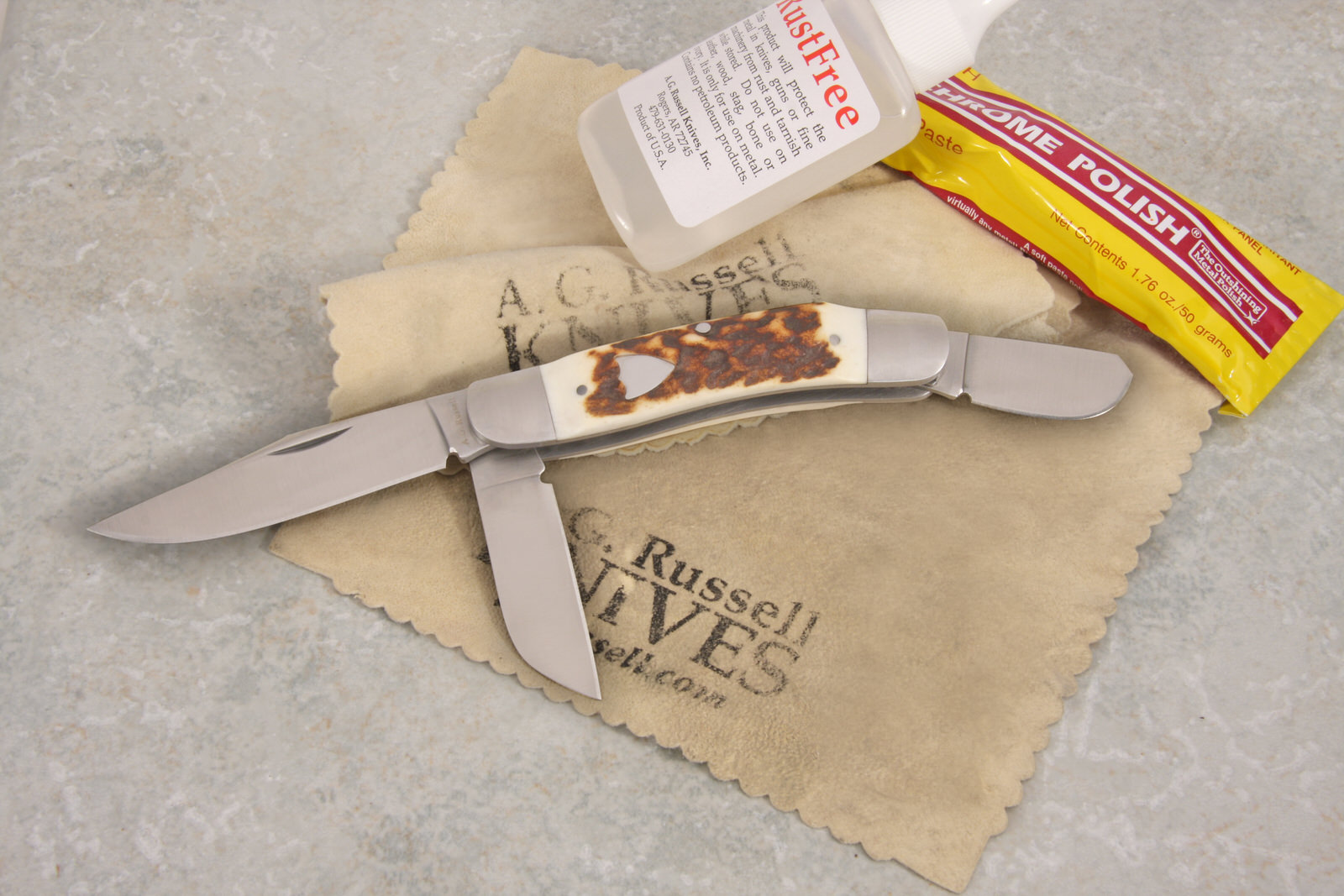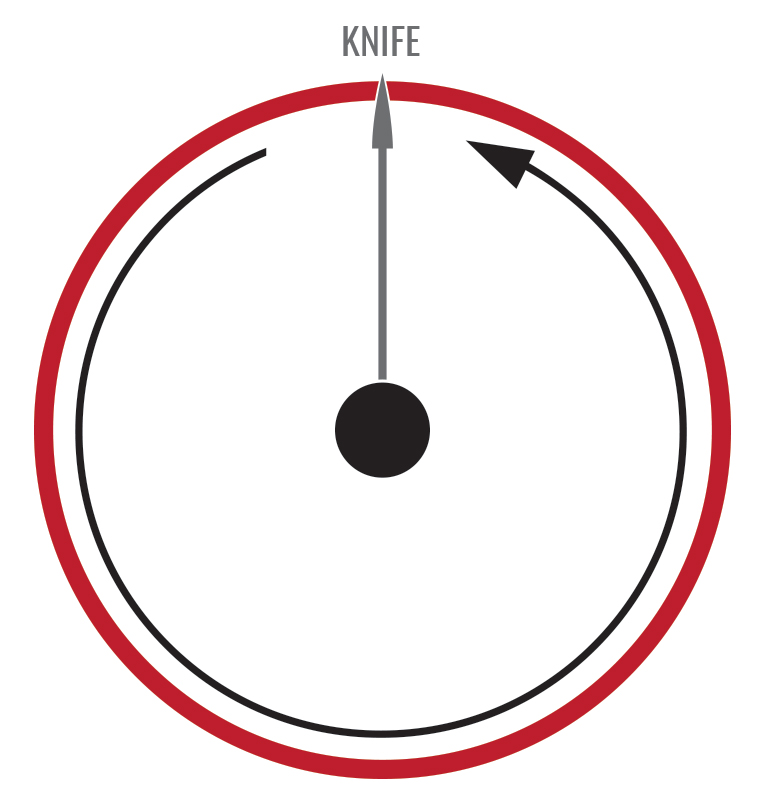Maintenance, General, Safety, Kitchen, Knife & Knife Show Etiquette Tips
 How do I keep my knife well maintained?
How do I keep my knife well maintained?
- Clean Your Knife
Folders: If it is a folding knife, keep the inside clean. Use a can of compressed air to clean out pocket lint.
Moderately Dirty: Typically, I clean my knife with soft T-shirt material.
REALLY Dirty: If your blade is really dirty, wet your cloth, put a little soap on it, and clean the blade. Soap will not hurt your knife as long as you clean it off. The important thing to remember is to dry your knife VERY thoroughly. For that reason I do not suggest fully submerging your knife in water, especially the pivot. Water can damage leather handles, so keep those dry.
STICKY: If your knife is sticky from sap, glue, or from cutting tape, get a bottle of GooGone. You can get it at any general store in the cleaning supplies section. It will not hurt your blade, but I would avoid the pivot. Just put some of it on your cloth and wipe your blade down.
Clean EDC: To keep your blade sanitized enough to be able to pick out a splint or cut up some food, use rubbing alcohol or hand sanitizer to keep your blade germ free.
- Oil Your Knife
Keep the pivot well lubricated. Do not use WD-40. It will gunk up your knife over time. Use a superior lubricant like Quick Release.
If it is non-stainless steel, or you use it live in a wet environment (especially if it is salty), make sure to oil your knife well and often. Even if it is stainless steel, we still recommend oiling at least twice a year. If you already have protective oil for your guns that will work fine, if you do not, try RustFree. One bottle will go a long way, and will work well to protect any steel whether it is a knife or not. First, make sure your knife is clean. If you oil a dirty knife, all you are doing is locking in dirt under a layer of protective oil. Wash your hands to remove any excess natural oils. Then take your bottle of RustFree and put two drops on each side of the blade. With your finger, spread the oil all over the blade. Remove excess oil with a paper towel or soft cloth.
- Sharpen Your Knife
View our knife sharpening guides.
General Knife Tips
- Keep your knife clean, dry, and well maintained.
A clean, dry knife will last longer, and perform better. See the above maintenance steps for instructions.
- Never keep your knife in a leather sheath for long-term storage.
The natural oils in the leather encourage rust over time, even on stainless steel blades. Stainless steel means it stains LESS, not that it is stain FREE. Leather will also damage your nickel silver or brass guards on a knife if left in the sheath for long periods.
- Do not heat up a knife.
Many times this is done inadvertently with some sort of belt grinder going too fast. If you grind metal too fast you will heat up the metal with the friction. Blades are heat treated to the correct temperature to improve the molecular structure of the steel. If you ruin the heat treatment the knife it will no longer hold an edge. In the same vein, never check your car battery with your knife - that's a fantastic way to ruin your knife.
Knife Safety Tips
- Always handle any sharp object with care.
- Use the right tool for the right job. Not only will this tip help you keep all your digits, but you will be much less likely to ruin your tool. Never use a knife as a can opener, screwdriver, or pry bar.
- Use sharp knives. Dull knives increase your odds of injury.
- Always cut away from yourself.
- Never use a locking blade with a broken lock. This tip sounds obvious, but you would be surprised by how many injuries occur this way.
- Never try to catch a knife. Let it fall to the ground.
- Never run with an open blade.
- Treat and sanitize any cuts right away.
- The Blood Circle: The Blood Circle (AKA the Safety Circle) describes the area within the radius of extended arm and sharp object (knife, axe, etc.) of the user. No other persons should be within the Blood Circle while a sharp object is in use.
Kitchen Knife Tips
- Hand wash your knives. Never put them in the dishwasher. Sharp objects banging around is a sure way to dull them.
- Dry your knives immediately. Never let them air-dry.
- Use the right tool for the right job. If your knife is a slicer do not use it to chop.
- Maintain your knives with our ceramic sharpener.
Knife Etiquette
- Hand a knife over handle first.
- When someone hands you a knife, return it how they gave it to you. If it was closed, return it closed. If it was open, return it open (handle first). This is an old superstition, and thought to bring bad luck if you return the knife differently.
- Boy Scout Code – The majority of people do not follow Boy Scout code, but the Boy Scouts do have the most pervasive knife rules of any organization and it is worth being aware of them. If there are any scouts reading please correct me if I misstate anything.
- Handing a Knife Over: Boy Scout code dictates that when handing a knife over, the receiver will say, “Thank you” to indicate that he has full control of the knife. The giver will not let go of the knife until he has confirmed that the receiver has full control.
- The Blood Circle: The Blood Circle (AKA the Safety Circle) describes the area within the radius of extended arm and sharp object (knife, axe, etc.) of the user. No other persons should be within the Blood Circle while a sharp object is in use.
Knife Show Etiquette
- Always ask before you pick up a knife. I always ask, “May I?” and indicate the knife I want to examine before I pick it up.
- Do not ask a handmade knife maker how long it took to make a knife. Time spent does not necessarily indicate quality. Some knife makers are faster than others. It is considered a rude question. More appropriate questions might be: “Where did you get your inspiration from?” or “What materials did you use?”
- Do not balk at a handmade maker’s prices. The knife might be too expensive for you perhaps, but that does not mean that the knife is not at an appropriate price. Many people fail to account for the years of experience, tutelage, and self-study knife makers put into each of their knives. Not to mention numerous failed attempts at new designs, techniques, as well as constant, endless practice to perfect what they do. Then you add in basics like the proper tools, exotic materials, insurance, etc. Most makers have been in the business for years and typically know about what their knives are worth. That does not mean all makers are averse to haggling, and many will tell you if they are willing to come down on the sticker price. I apologize for rambling a little, but just be polite and you'll do dandy.
